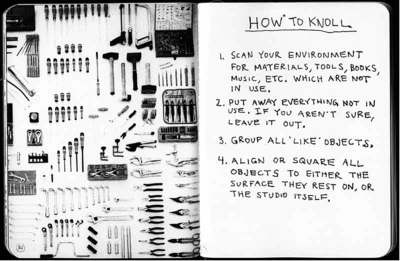This series of blog posts about KNOLLING is dedicated to Andrew Kromelow who coined the term ‘knolling’ in 1987 and to Tom Sachs who expanded on the concept of knolling to ‘Always Be Knolling’.

Knolling is defined in Wikipedia as “the process of arranging related objects in parallel or 90-degree angles as a method of organization”. The original phrase, knolling, was coined in 1987 by Andrew Kromelow, a janitor in the furniture fabrication shop of Frank Gehry. Gehry was designing chairs for the legendary, Knoll Furniture Company. Kromelow was particularly impressed with the furniture designed by Florence Knoll.
HISTORY OF KNOLL FURNITURE

From http://www.knoll.com/designer/Florence-Knoll
ANDREW KROMELOW
Andrew Kromelow especially liked the clean, angular lines of Florence Knoll’s designs which can be seen above. As a result, at the end of the workday, Kromelow would collect all the tools that had been left out in the work studio and organized them in a similar geometric manner then photograph them from the top. No photographs of Kromelow’s work seem to have survived, publically.

The above image from Tom Sach’s, Ten Bullets, #8: “ALWAYS BE KNOLLING’ suggests what a Kromelow ‘flat lay-overhead photo’ might have looked like.”The result was an organized surface that allowed the user to see all objects at once”. Kromelow referred to this as ‘knolling’ due to the idea’s inspiration from Florence Knoll’s design sensibility. The term, the concept and the ‘flat lay photography’ Kromelow made of his arrangements caught on thanks to another person in Gehry’s employment.
“ALWAYS BE KNOLLING”
Tom Sachs, an artist and sculptor who also worked in Gehry’s studio, popularized Kromelow’s knolling and his ‘flat lay photography’ process. According to the blog post in CreativeDesignMagazine.com, Sachs created a piece about knolling and adopted the phrase, “Always be Knolling” (or ABK for short) as a motto for his work. By 1987, knolling had officially become a trend. But what transpired between 1987 and 2009?
One wonders because nothing more seems to be available about it again until the 2009 blog post on CreativeMarket.com, ‘What Is Knolling? The Overhead Photography Trend Explained’. Supposedly, this style of organizational layout has been used for over three decades to shape brands and sell products. No examples were available. Instead, decades before the social media venue, Instagram, had the popular account, ‘The Flat Lays’, before the existence of social media at all, and separate from Kromelow’s organizing technique, knolling existed as a graphic design layout and branding inspiration. But it was not known as knolling and it was before 1987.

WHEN ‘KNOLLING’ WAS JUST A CHARRETTE CORPORATION LAYOUT AND BRANDING TECHNIQUE
The process of ‘knolling’ existed independent of Knoll and apparently previous to Andrew Kromelow’s coining a phrase for it. It was a prominent style designing with type, graphic design layout, architectural presentation and products branding including overhead or flat lay photography. One company that prominently exemplified this pre-knolling sensibility was the Charrette Corporation. The architect David Paul Helpern, designer of the NYC Charrette Corporation flagship store and the graphic design/branding designer, Johanna Bohoy, the Art Director at Charette’s Headquarters in Woburn, Massachusetts were responsible for its conception. This can be traced back to the early 1980’s rather than the late 1980’s when the term knolling was coined.
There is a series of articles about the Charrette Corporation written by me, the NY Graphic Design Examiner on examiner.com. Many samples of their forward-thinking graphic design and branding style are included. Suffice to say, whether it is called knolling or attributed to the earlier Charrette Corporation methodology, the result is very calming on the brain to observe objects in an orderly rather than chaotic manner. This seems to be especially true for artistic, creative brain dominant people.
TECHNOLOGY TAKES ON KNOLLING
To add to this, technology has taken leaps, specifically with the creation of social media venues which facilitates present day knolling. But according to my research, history clearly illustrates that the clean, perpendicular and parallel lined style of graphic design layout, now known as knolling, was not a revolutionary idea and did not begin with Florence Knoll or Andrew Kromelow in 1987. This is not to deny that the advent of social media has allowed knolling to become very practical, even pedestrian in its incarnation as ‘flat lay photography’. Layout and branding are now easily and attractively showcased by Instagram, Pinterest and Tumblr, pictured directly above and below.

Looking for an easy way to incorporate some knolling into your next project? We’ve got you covered. From CreativeMarket.com
CONCLUSION
Life has a way of providing what is needed at a particular time in history. Credit it to The Charrette Corporation, Florence Knoll, Andrew Kromelow or Tom Sachs. They have all played a part in transforming the disciplines of design layout and branding forward to another level of usefulness and appeal in the world of product marketing. But is there more to it than that?!
My next blog post will attempt to answer that question and this one specifically:
Can It Help Organize My Costume Jewelry Collection?

Another simple but great knolling photo on Instagram comes from luisamaria.ac. Rather than group items by category or type, she created a photograph that was themed by color. This knolling photograph is predominantly orange and features a toy moose, a notebook, flowers and more.
SOURCES AND RESOURCES
KNOLLING Part Two: Can Knolling Help Organize My Vintage Jewelry Collection?
What Is Knolling? The Overhead Photography Trend Explained
Knoll
Florence Knoll
Frank Gehry
Andrew Kromelow
Tom Sachs
Ten Bullets Website aka Tom Sachs Working To Code
Things Organized Neatly
Flat Lay Photography
Charrette Corporation Layout and Branding Technology
Alison Gilbert, NY Graphic Design Examiner







